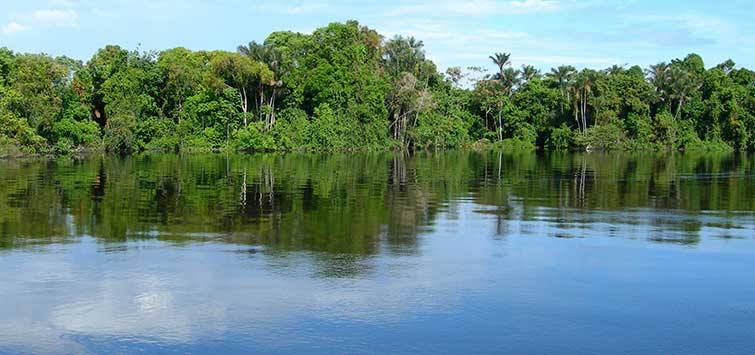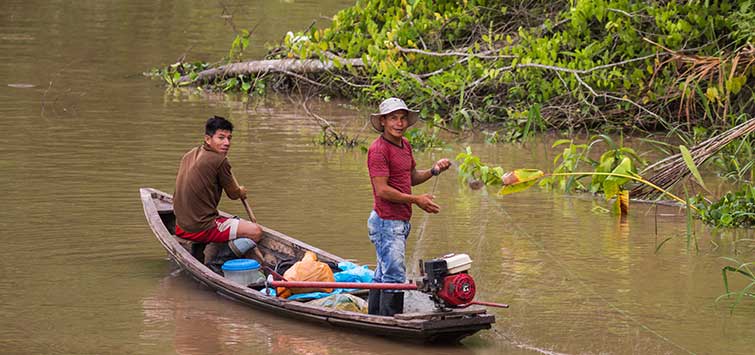Hope Along the Rio Negro Part 2: Rising Waters
Author: Randy Carey
In the second part of his series, the author discusses his experiences with the high waters, flooded forests, and floating meadows of the Amazonian rainy season.
Heading Towards the River
An excited Captain Mo told us that he had never seen this before—not on the Rio Negro. Before the urban shoreline of Manaus had disappeared from view, we were already preparing to engage the river.
Large patches of floating grass, many that could be measured in cubic yards, were drifting past both sides of the Victoria Amazonica. These patches are called “floating meadows.”
Floating Meadows, and a Lesson
Floating meadows are dislodged patches of grasses that begin upstream as growth along the river banks. Colonies of small fish take refuge among the roots of these grasses. The rising water tugs at the grass and eventually wrestles patches from the shoreline. Clinging to the world they know, the small fish remain within the safety of these roots. A floating meadow will drift downstream for days and long distances, all the time maintaining its colony of aquatic life.
This phenomenon is well known in the Amazon. In fact, during that very month of our discovery Wayne Leibel was writing about them in his column, “Cichlidophiles” (TFH March 2006). What was unusual about these is that never before had Mo seen any significant amount of floating meadows streaming down the Rio Negro—not until this season.
The Experiment
Scott was recruiting anyone who wanted to investigate. As the Amazonica slowed, volunteers cast off in two canoes, selecting and then circling a few sizable meadows. The techniques for researching these patches are not widely known and almost all the people in the canoes were amateurs. So they experimented with large seining nets, searching for a way to encircle and capture the life under the meadows. But extracting fish from the dense vegetation proved problematic. After an hour of various approaches, the canoes returned to the boat. Scott confessed that they could not find a workable technique. Consequently they netted nothing of informational value, only a couple of juvenile tetras clinging to the roots.
Even though the experiment failed, these floating meadows did have a lesson to teach: The river never stays the same. Something triggered the unusual presence of these meadows on the Rio Negro. Whatever it was, it was something different about this year. But on this river every year is different from the others.
The Ever-Changing River
Throughout the course of a year, the water level is either rising or falling. The week and even month when the level starts to rise or fall will vary year to year. In 1982/1983 and in 1997/1998 the water began to rise in late February, but in 1995/1996 it began in November. Even just how high the river rises and how low it falls can vary considerably. The river is constantly changing, throughout the years as well as between the years.
As anyone who travels it throughout the year could tell you, trying to map the boundary of river to land along the Rio Negro would be a laughably fruitless task. As the water rises, the river swallows islands and overtakes large tracts of land. As the water recedes, so do the boundaries. At best, even the most detailed map would only be a snapshot of a moving target.
Mo didn’t want to take a chance on navigating a sizable boat through this ever-changing river. Somewhere around the halfway mark to Barcelos, the captain dispatched crew members to a small house boat. An aged and weathered man smiled and greeted them. After a brief negotiation the man set off to gather his belongings. He would be joining us. Our captain recruited this local boatman to direct us through the safest channels and to steer us clear of ever-shifting sandbars. Captain Mo grew up along the river and regularly journeys up to Barcelos, but the river is always changing. Only a local would know what the river is like this week.
High Expectations and High Waters
The Rio Negro is the largest tributary of the Amazon. It is long, and has many large tributaries of its own, but its vastness is measured by its volume. The Rio Negro annually dispenses into the Amazon three times the amount of water that flows through the Mississippi during the same period. As a river with this much volume spreads outwardly, it carves channels into the landscape. Arguably, the lower portion of this river is a series of parallel and interconnecting channels that collectively can span miles in width. One can seldom look to the left and to the right and see the absolute east and west boundaries of the Rio Negro.
A river this wide is a poor source for the wildlife and aquarium-sized fish that we sought—those are to be found in the smaller rivers and streams that branch throughout the rainforest. The purpose of the Victoria Amazonica is to carry us 300 miles to Barcelos. But in order to explore along the way we frequently pulled off to the side, dropped anchor, and canoed into these smaller rainforest streams.
The rising waters affect these smaller rivers as well. On one occasion Labbish guided us up one of his favorite streams. He raised our expectations as he described the blackwater falls and rapids that the previous year’s tour had explored. But when we reached the location, only the landmarks confirmed it was the same place; the anticipated watermarks could not be found. It was the same fourth week in January, but the water was so high this year that we just paddled over now-submerged waterfalls.
The most frustrating part of the high waters was its effect on fish collecting.
As we traveled toward Barcelos we moved into cardinal tetra territory. The agenda for Wednesday morning was to collect cardinal tetras by the hundreds. After all, the locals collect and sell them in lots of a thousand. We were being led to a site that proved itself last year. But like the stream with the waterfall, we arrived at a site that looked nothing like it did the previous year. Last year at this time the expedition ran nets through a stream glistening at the surface with the metallic blue of cardinals. This year the stream was swallowed by a flooded plain.
Scott, determined to find the schools of cardinal tetras he had told us about, donned a snorkel and searched with the vantage of an underwater view. Unlike a stream, flooded grassland is very expansive, and while they could be anywhere, Scott saw them nowhere.
While the rising waters hampered our collection efforts, it is this phenomenon that brings opportunity to the fishes of this area. At the low-water mark all the fishes, big and small, are forced to share the same channels of water. Within these streams they compete for food, and they compete for refuge so as not to become food. Once the water level rises, the crowding is reversed. The submerged grassy banks provide refuge and food. As the waters overflow the banks and flood the surrounding area, the fish disperse, exploiting their opportunities to forage for food, to seek shelter among vegetation, and to spawn. For months the waters flood much of the forest basin. Insects and berries fall into the water, feeding the growing populations of fish.
Survival of the Fittest (and Luckiest)
Months later the trend reverses. As the water recedes, the previously expanding fish populations are forced into competition. While survival is much aligned with being the fittest, luck is a factor as well. Shallows in the flooded areas will become small ponds of trapped fish. These fish are doomed to serve as food, either for bigger fish or for animals foraging on the drying pond’s edges. Lucky are those that are found by fisherman and collected for the aquarium hobby.
Spawning
There is no better time for the fishes of this area to spawn than when the waters begin to rise. A species that is inclined to spawn as the water level drops would not survive here. Growing fry would be greatly disadvantaged as the fish population becomes denser and as food and shelter become scarcer. The species that survive here are triggered to spawn with rising water.
The opportunity provided by flooded plains is greatest for those species that scatter their eggs like the tetras, other characins, and many catfishes. During a spawning season most scatterers produce thousands of eggs per pair, many times more eggs than those species showing parental care. When given the opportunity of an expansive spawning ground with low predation, the population of scattering species soars.
Given that the most frequently collected aquarium species of the Rio Negro is the cardinal tetra, this phenomenon is relevant. Every spawning season the cardinals and other tetras reproduce by the millions, if not by the tens of millions. As the water recedes, only so many of these small fish will survive the seasonal crowding. Millions die annually.
No Harm Done
To the aquarist, this should be an important realization. The aquarium trade is not shortening the life of the fish collected in the Rio Negro. The fish collected and shipped to hobbyists alleviates the number that will die in nature. One could argue that for every thousand fish collected to live in an aquarium there are a thousand less fish doomed to die in the river. Indeed, most aquarium fish are collected as the water is receding, typically August through February. Those months, fortunately, correspond to the time of highest demand from the Northern hemisphere.
Furthermore, due to the high reproduction rates of tetras, their populations are resilient. Project Piaba has conducted annual research that reveals the cardinal tetra population has not suffered despite over 20 million being exported from Barcelos year after year. The aquarium fishes of the Rio Negro are indeed an annually renewable resource.
Tetras in a Shallow Pool
One morning while we were near Barcelos, we grounded our canoes on a leafy bank. We knew how the routine worked. We would glide a seining net along the bank, lift it above the water, and sort through the dripping leaf clutter, searching for Apistogramma and other small cichlids. We found them.
While the team worked exclusively along the bank, I had been eyeing this small, shallow pool of water, resting not far from the shore. I would expect to see such pools when the water is falling, but my mind was challenged to conceive how an isolated pool might be formed during rising waters. I left the river bank, removed a large dip net from the boat, and ran it through the shallow pool of water. The pool contained tetras. Resembling a head-and-tail-light tetra, they were not excessively pretty, but they were a typical aquarium fish species.
Because of their novelty, I bagged some of these tetras. They would be photographed and then left in the care of Project Piaba. How these tetras got into that shallow pool, I don’t know. Was the pool destined to dry up before it would merge with the rising waters of the nearby stream? I would never know. Perhaps I saved these fish. But when you think of it, such a feat is not all that remarkable. Every time I buy wild-caught specimens from this rainforest, I am saving fish.

.png?h=595&iar=0&w=2781&hash=5FD5E69473BCC22199FBFA2FB71B6033)



